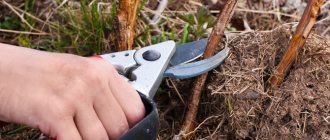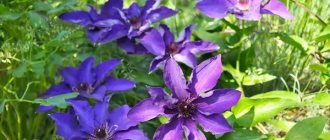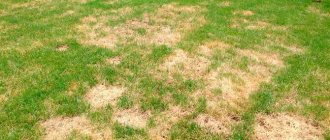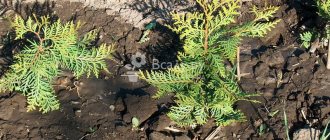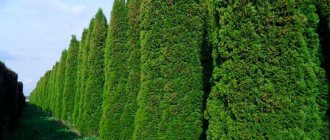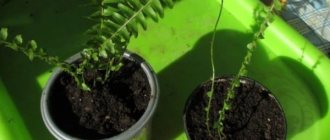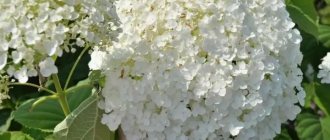Evergreens are generally unpretentious to grow, but still require compliance with the simplest rules of agricultural technology. Caring for thujas in spring is the most important, since at this time the tree is most vulnerable to environmental conditions. Knowing the main nuances, you can protect the plant from many troubles and achieve good needle growth.
You may like:
- Reproduction of Thuja
- Types and varieties of thuja with photos and names
When to open thujas after winter
Although bright green bushes and trees harmonize beautifully with the snow-white cover, experienced gardeners recommend covering all thujas for the winter . For this purpose, non-woven, light- and breathable material is used. If it so happens that with the onset of cold weather the plants are left without shelter, it is necessary to provide them with additional protection in February. At this time, daylight hours increase, despite the low temperature, the sun warms up.
Under the burning rays of spring, the needles wake up, while the root system is still sleeping. As a result, active evaporation of moisture occurs. The roots do not compensate for the lost moisture and, as a result, the shoots dry out and turn yellow. It is no longer possible to restore damaged branches. Therefore, you should not ignore the shelter; it helps preserve the decorative appearance of the tree.
It is advisable to open thujas after winter after awakening the root system. The snow, or at least the bulk of it, should come off the ground. The most suitable period is the time of swelling of the first buds on deciduous trees and bushes. But before this, it is advisable to periodically open the plants in cloudy weather so that they adapt to the light.
Removing mulch
If you scattered mulch for the winter, carefully move it away from the tree trunk. This measure is necessary so that the earth around the plant warms up faster. After this, loosen the soil to a depth of 5-8 cm so that oxygen can freely pass to the root system. In this case, it is necessary to do weeding - remove all weeds.
There is no need to completely remove the mulch. When the weather settles and consistently warm days arrive - at the end of April-May, the protective layer can be returned to its original place. Sometimes branches are wrapped for the winter so that they do not break under the weight of snow. In spring, be sure to remove the threads around the crown.
If you have scattered mulch for the winter, carefully move it away from the tree trunk.
Features of soil care
The condition of the soil for thuja is no less important than protecting the needles from burns. Evergreens love moderately moist, fertilized, loose soil. Stagnation of water is detrimental for them, so even when planting, you need to take care to add sufficient drainage to the pit.
Growing thuja involves the following work with the soil:
- weed removal;
- loosening;
- mulching.
The soil must be free of weeds . The roots of other plants take away some of the nutrients. In addition, they can be carriers of diseases and attract pests. It is advisable to periodically loosen the soil to improve its breathability and moisture absorption. But do this carefully, without going deeper than 10 cm, since the root system is superficial.
To simplify your work, and at the same time create favorable conditions for growth, you can mulch the tree trunk circle . Compost, humus or crushed pine bark can be used as a covering material. Mulch stops the growth of weeds, retains moisture, improves the vital activity of soil microorganisms, enriching the composition of the soil.
What can you water with and what is the effect of it?
To stimulate growth and development, it is recommended to feed the young tree . However, fertilizers can be applied no earlier than 2–3 years after planting. This is explained by the fact that the necessary nutrients are introduced into the soil along with the earthen ball in which the roots of the seedling are located.
When the thuja reaches two years of age, you can begin to feed it with special mineral supplements intended for fertilizing coniferous trees.
Kemira-Universal is well suited for this. The product at the rate of 50 g per m² is diluted in 10 liters of water and watered the area around the plant. Then you need to loosen it. Loosening will allow the fertilizer to be better absorbed into the soil.
Thuja occidentalis is a moisture-loving tree. For its full development and formation, it is necessary to observe the correct watering regime. It must be timely and in sufficient quantity to satisfy the tree's basic need for moisture.
Watering and sprinkling thuja
A common misconception among gardeners is that evergreens need to be watered only when the weather gets hot. In fact, already in April, and in warm regions and in March, under the influence of sunlight, moisture begins to actively evaporate. The soil quickly uses up reserves from melted snow, so it is necessary to replenish them.
To prevent the needles from drying out, in warm weather it is advisable to water the thuja once a week. In hot weather, watering should be increased to 2 times a week. A small tree about 3-5 years old requires 1 bucket of water. You can pour 2-3 buckets under adult plants. In extreme heat, the volume of water is doubled.
Spring care involves weekly sprinkling. This is especially important in the first warm month, when scaly needles evaporate moisture very actively. Spraying the crown helps open the pores, which intensifies the pine aroma. The plant begins to breathe and, accordingly, grows faster. Room water temperature is the most acceptable for sprinkling. The best time to spray is early in the morning or evening, when there is no sun.
Consequences of ignoring watering or doing it incorrectly
Failure to comply with the watering regime - its shortage or excess - can lead to dire consequences. Insufficient moisture leads to drying out of the soil and inhibition of root development. Overwatering is no less dangerous for the health of the thuja and can lead to rot and death of the plant.
It is very important to comply with moisture requirements in hot months , since under solar conditions the needles lose a large amount of moisture. The main condition for caring for a tree in summer is the regular and timely provision of liquid to the young tree.
Therapeutic pruning of thuja
All damaged branches require immediate removal. You should not leave yellowed shoots in the hope of their restoration. The burned needle is dead. The same applies to blackened areas. They are struck by a fungal infection that can spread throughout the tree. Therefore, you need to immediately trim them and treat them with an antifungal drug , for example, “Hom”.
It is important to carefully examine the entire plant. If it is large, it is worth spreading the branches and looking into the middle. In the depths, dead needles also turn yellow. You definitely need to remove it. Otherwise, the damaged areas may dry out, disrupting the shape of the crown and triggering the development of diseases.
The best period for therapeutic pruning is April. But if time is lost, you shouldn’t wait until next year. If the needles have turned yellow or blackened, they are removed at any season. In spring and summer, crown thinning can be done. This is done to improve air circulation, which prevents the development of diseases.
When pruning, it is important to adhere to the following rules:
- Carry out manipulations only in dry weather. You should not do this immediately after rain or in the rain, as the appearance of the thuja will be slightly distorted.
- First remove dry and diseased branches, and then begin thinning. It is important not to overdo it so as not to spoil the crown.
- To form a more magnificent tree, trim only the top, without touching the side branches.
- It is not necessary to thin out thujas growing in the shade. Usually they do not have a thick crown.
For mature plants, it is recommended to carry out preventive pruning annually . Young seedlings up to 3 years old can be left alone if their needles are in perfect condition. If large branches were removed during the pruning process, the cut areas should be treated with garden varnish or a special paste. “Zhivitsa” and “Robin Green” are best suited, since they contain pine resin, which compensates for the thuja’s lack of its own.
Description
This is a plant not found in Russian climatic conditions. Its homeland is America and East Asia. But the tree has taken root quite well in our environment. Some of its varieties are grown even in the north of Russia.
Interesting. The word "thuja" means "incense" or "sacrifice." This is associated with the pleasant aroma that spreads when some types of plants are burned.
The plant belongs to the Cypress family. It is evergreen, the needles consist of scales overlapping each other. At home, it almost always grows to a height of 20 m, but in Russia it rarely reaches 11 meters in height.
There are such types of thuja:
- Thuja occidentalis (“Smaragd”) is the most common species in gardening. It has a large number of varieties.
- Japanese thuja grows in mountainous areas. Its difference is its beautiful needles with different colors. On a summer cottage it can reach a height of up to 18 m. In large cities it takes root with difficulty.
- Korean thuja has a wide, spreading crown and soft needles.
- Folded thuja is very sensitive to cold. The plant is very tall and can reach a height of 60 m. It has a pleasant aroma.
- Oriental thuja has medicinal properties. Its branches resemble the shape of a fan. The plant does not tolerate frost well.
Decorative haircut of thuja
A shaping haircut is done in 2 cases:
- I don’t like the natural density of the crown;
- I'm not happy with the shape of the tree.
Depending on the thuja variety, pruning is carried out 2 times a year or once every few years . If the annual growth is more than 20 cm, you need to adjust the length of the shoots in spring and summer. With a growth rate of 10-15 cm, a single haircut is sufficient. Dwarf plants that grow very slowly are practically not touched at all. They naturally take on a beautiful shape. All that is required of the gardener is to shorten the branches that have escaped from the main mass.
It is important to know not only how to trim thuja correctly, but also when to do it. Removing branches before buds break stops the growing season. This can be useful when removing old branches and thinning the crown. If growing green mass is important, it is better to trim the thuja after it has finished flowering.
Hedge trimming
The easiest way to trim hedges is to trim them. Since the trees should fit tightly to each other, the side branches should not be touched. It is enough to trim the tops to the same height. In this case, at least 2/3 of the original height should remain. Next year all that remains is to trim the overgrown top.
Topiary haircut of thuja
Nowadays it is fashionable to give thujas various shapes. A master can create any sculpture with just garden shears. Beginners without practice can form geometric shapes: cones, pyramids, balls, cubes. When choosing a form, it is advisable to focus on the natural habit.
The spiral shape of the crown is very popular. It requires painstaking work, but is still not as difficult as it might seem at first. The spiral looks best on tall plants. Suitable varieties are Brabant and Smaragd. To create a figure you need to do the following:
- tie a rope or ribbon to the top, and then wrap it in a spiral along the entire length of the thuja, adjusting the desired width of the turns;
- Use garden shears to make a light outline along the resulting marking;
- carry out a deeper cut so that the difference in the branches is smooth but well defined;
- remove the rope from the tree.
Another way to create a spiral is to grow thuja in a wire frame. As soon as the shoots of the young tree begin to peek out from the frame, they are cut along the contour. Then the frame is removed. It is important not to overdo the pruning and create bare shoots. The needles will no longer grow on them, and as a result, unsightly bald patches will appear.
Transfer
Arborvitae can be replanted from March to November. If the procedure is performed correctly, they tolerate it well. Having prepared the planting hole in advance, they begin to remove the tree. A circle with a diameter of 1 m is drawn around it. The thuja trunk should be in its center.
Armed with a sharp spatula, they pierce the circle along its entire length. Then the soil is carefully lifted. You can't do it without helpers. The thuja removed from the ground is loaded onto a cart and transported to a new location.
The elegant beauty of the thuja and the ease of its cultivation make it a favorite of gardeners and landscape designers. This evergreen tree is appropriate everywhere: in the country, in the front garden, in the park. It also has beneficial properties. If you stay near thujas for 30 minutes or more, your thoughts and feelings will come into order and nervous tension will disappear. They also have a beneficial effect on the air, saturating it with oxygen, purifying and killing harmful microorganisms.
You can experiment endlessly with planting thujas. They are equally effective as part of hedges and when placed alone, and are often used to design paths. Their crown can be given any shape, turning the dacha into a fabulous corner.
Evergreen shrubs and trees are highly valued by summer residents and owners of private houses, as they help create a noble atmosphere on the site and also do not require complex care. One of them is thuja. This tree not only pleases the eye with its elegant appearance, but also has a pleasant aroma. It is quite unpretentious, but very moisture-loving, so lovers of such specimens need to learn the rules and nuances of watering.
Fertilizing in spring and summer
Caring for evergreens is easy. Strong trees and shrubs do not need various growth stimulants. Therefore, some gardeners reduce caring for thuja to timely watering and sprinkling. Feeding is more needed for young plants that intensively grow green mass.
Fertilizers are applied immediately upon planting. They have a positive effect on strengthening the root system and the adaptation of a tree or shrub in open ground, especially if the seedling previously grew in a container. Then you can not fertilize the young thuja for 2 years. Good nutrition is quite enough for this time.
Fertilizing can be done in early spring , as soon as the snow melts and the ground thaws. It will launch active growth of the plant and improve its attractiveness. What to feed thujas in spring? Organic and mineral fertilizers are suitable for this purpose. It is best to choose complex preparations intended for coniferous crops. It is allowed to use ammonium nitrate in the amount of 1 tbsp. l. for 1 bucket of water.
The Finnish Fertika fertilizer shows good results. It is suitable for fertilizing in summer. For medium-sized thujas, only 40 g of product is enough. The Zircon solution has also proven itself. It enhances the ability to absorb nutrients and moisture, protects against ultraviolet radiation, and helps to survive stress after a transplant or haircut.
It is recommended to water the bush well before applying fertilizer. And only then add fertilizing. Afterwards it is recommended to mulch the tree trunk circle. This will improve the absorption of microelements and prevent the rapid evaporation of moisture. At the dacha, it is not always possible to apply fertilizing in a timely manner. In this case, you can use slow-release fertilizers. It is enough to embed them in the soil, and then water the thuja from time to time.
It must be remembered that an excess of fertilizers is more dangerous than their absence. Therefore, you should not get carried away with fertilizing. On average, they are applied once every 10-14 days. Each product has a different concentration, so it is important to follow the instructions. If it is necessary to stop the growth of thuja, it is enough to reduce the application of nitrogen fertilizers.
Selection of seedlings
Nurseries and specialty stores offer a large selection of thuja seedlings of different varieties, differing in age and size. You can purchase a small tree and place it in your dacha after growing it. There will be no difficulties with this. Planting young trees is preferable: they take root faster. If you want to decorate the area right away, it is better to choose an already large, developed plant.
When buying a seedling, you need to carefully examine it, paying special attention to 2 conditions:
- how moist the soil in the container is;
- how firmly the scales adhere to the shoots.
The branches of a high-quality seedling are strong, elastic, without suspicious spots or signs of damage by pests or diseases. The needles do not fall off from them. Having brought the plant home, it needs to be planted and watered as quickly as possible.
If the root system of the thuja is open, it is placed in the ground in the spring, otherwise it will not take root. Trees growing in containers can also be planted in summer.
Protecting thujas from pests
Like any other thuja plants, they are susceptible to pests. Thuja aphids, moths, fungi, and false scale insects pose a particular danger to them. Timely treatment is the prevention of possible diseases. It is best to do it in the spring. If time is lost, then at the beginning of summer, but not later, since pests intensify their activity already in June.
Professionals recommend treating plants with one of the complex preparations, which helps with all common diseases. The best tools to do the job are:
- "Karbofos";
- "Rogor";
- "Fundazol";
- "Cypermethrin."
Even sick thujas recover quickly with proper care. But it is still advisable not to neglect preventive measures or at least start treatment at the initial stage of the disease.
Preventive spraying
In spring, not only plants wake up, but also pests. If they are not dealt with, a “mass attack” of parasites can worsen the appearance of the plant and lead to disease or death. You also need to protect thuja from diseases and fungal infections.
Spraying against diseases
Insecticidal and fungicidal treatment is carried out using a garden sprayer. The solution is prepared strictly according to the instructions. The entire crown is processed, outside and inside, as well as skeletal branches. Prevention is needed against such common thuja diseases as:
- snowy and ordinary shutte
- rust
- fusarium
- root rot
For treatment, it is necessary to choose complex systemic drugs: “Skor”, “Rayok”, “Topaz”, “Chorus”, “Strobi”, “Fundazol”. To prevent root rot, “Ordan” and “Rakurs” are suitable.
Supporters of biological products can use such products as Fitosporin, Alirin, and Gamair to treat thujas.
Advice! It is advisable to use biological preparations when the air temperature is between +12-20°C.
Caring for young thujas
Beginning gardeners often wonder when to plant thujas - in spring or autumn. Both options are possible . But spring is preferable, because over the summer the coniferous plant has time to adapt, grow its root system and, as a result, be more prepared to face the winter. For this reason, the survival rate of spring plantings is better than that of autumn ones.
Starting from the age of 3, caring for thujas is no different from caring for adult shrubs. But if you grow plants from seeds or cuttings, young plantings need to be given even more attention. The main measures are treatment with strengthening and stimulating drugs. In the first year of life, they help to grow the root system and take root. And on the second, they increase resistance to diseases.
The drug "Epin" showed good results. They need to be sprayed in calm weather when there is no sun. You can repeat the procedure once every 10 days throughout spring and summer. It is also recommended to feed the plants with phosphorus and potassium once every 3 weeks.
If the initial distance between the seedlings is small, you can transplant them to a permanent place in the spring. It is also worth replanting if the root collar is too deep. It is enough to lift the tree a little and strengthen it. To get a lush thuja in the shortest possible time, in spring all young shoots need to be pinched 1-2 cm. This activates the growth of side branches. This method is good for creating dense crowns and hedges.
Use in landscape design
Landscape designers most often use low thujas to create and design so-called rock gardens, which are artificial compositions for decorating areas. In addition, small evergreen shrubs can be used for planting hedges or decorating gazebos and flower beds.
And also, if you wish, you can use thuja in combination with other plants, forming unique plant compositions.
The use of dwarf thujas in rock gardens
A rock garden is an artificially created landscape composition that recreates in miniature a decorative area of a mountainous area, that is, the place in which coniferous plants occupy an important place.
Small varieties of decorative thujas, which differ from their relatives in their compactness and slow pace of development, are ideal for the full creation of a miniature rock garden.
Dwarf conifers
Small conifers are very popular among summer residents. Their size allows you to place several plants in one area at once. Frost resistance and ease of care make it possible to grow such dwarf forms in almost any climate.
Suitable site
In open ground, thuja will be comfortable in areas with light shading. Direct sunlight is harmful to wood. In spring and summer, it will wither and dry under them and, having weakened, will not survive the winter well. If you plant a thuja in dense shade, its decorative properties will suffer. Its development will slow down, the leaves will become pale, and they will grow less frequently, depriving the branches of their splendor.
Thuja does not like drafts and strong winds, so you need to choose a place for it that is reliably protected from them. The proximity of groundwater will only benefit the tree. The crop grows on any soil:
The main condition for it is sufficient humidity. But stagnation of water at the roots of a tree can destroy it. If the soil at the dacha is heavy and damp, a thick (15-20 cm) layer of drainage is poured onto the bottom of the planting hole. It is better to use large stones for it. In swampy areas, trenches are dug for drainage pipes.
The most beautiful plants grow in loose, fertile soil, consisting of three main components:
On nutrient-poor loams and sandy loam soil, special attention will have to be paid to fertilizing when caring for thuja.
